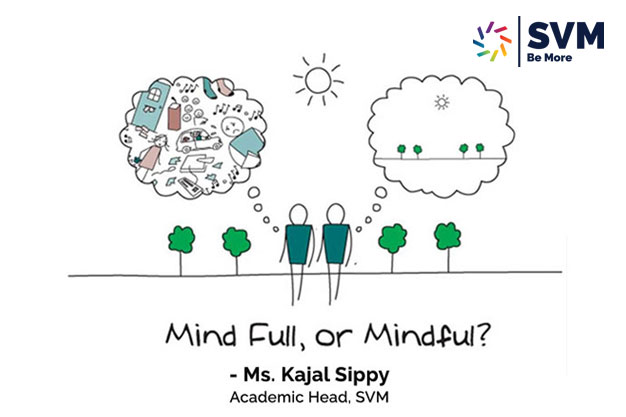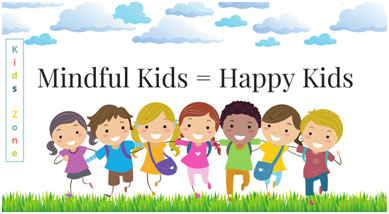
Mindfulness – The Super Power!!
Well, at the onset, I am sure the image given above has already set your minds ticking…
Yes, each one at this moment must be asking ourselves ,” Mind is full?” or “Are we Mindful?”
This brings us to very important question of : “What is Mindfulness, how does it work, or does it, really?”
As, humans we are , the most complex species on planet earth and thus, we are a bundle of complex emotions, ironies, feelings, moods ,anxieties, state of happiness, state of sorrows and many more . In order to feel one self, understand oneself and “Just BE”.
Mindfulness is that science that art, pshycology and science that is the eed of the hor. Need of this fast paced life, this rat race and speed and the irony here is all of this is at a standstill due to COVID -19. What a better time then to talk about Mindfulenss !!
So, how many of us can relate to this situation?
We live our life on autopilot. So much so that some days, we felt like we are walking through a dream. We are doing things, we are with people, we are even working toward our goals.
But we are not really showing up and being present, because our s are minds are almost always somewhere else. This isn’t to say that our lives aren’t good. It is . But mostly, we are disconnected from life as it is actually happening around us.
Don’t we all agree?
Instead of being present in our lives, we are spending time thinking about how things should be. And we are also spending even more time imagining how great life would be in the future once we reached a certain goal or ‘next step.’
We keep reaching those goals and ‘next steps.’ But somehow,we never find lasting happiness and instead of being present in those moments we had looked forward to for so long, we ware instead spending time imagining life in the future.
Do you see how this has become a horrific cycle?
So it is time we know and feel and believe in Mindfulness. Through which you can learn making a special effort to notice what’s happening in the present moment (in your mind, body and surroundings) – without judging anything. It has roots in Buddhism and meditation, but you don’t have to be spiritual, or have any particular beliefs, to try it.
The theory behind mindfulness is that by using various techniques to bring your attention to the present (usually focusing on your body and your breathing), you can:
- Notice how thoughts come and go in your mind. You may learn that they don’t have to define who you are, or your experience of the world, and you can let go of them.
- Notice what your body is telling you. For example, tension or anxiety can often be felt in your body (such as in a fast heartbeat, tense muscles or shallow breathing).
- Create space between you and your thoughts, so you can react more calmly.
Since I am an educator, I would focus on Mindfulness in children and in the school arena
Imagine this situation in your classroom
On a hot March morning, the hallways are abuzz with chatter and giggles at your school. As the Grade 3 learners from Ms ABC’s class ambled into their classroom from lunch and recess and put their jackets and lunch boxes into their cubbies, Ms ABC asked, “Can today’s mindful leader please come up front and begin?”
Rita, a 7 -year-old wearing a gray shirt and blue leggings, quietly took a cross-legged seat on the classroom rug facing her peers. With her palms facing up and resting on each knee, she began to tap her thumbs on each of her fingers, simultaneously repeating the words “I-am-calm-now” with each tap. Without hesitation, each of Rita’s classmates, along with their teacher, followed their mindful leader, tapping their thumbs and saying “I am calm now,” gently lowering their voices after each repetition until the room grew quiet. The teacher then asked her students to slowly make their way to their tables and take out their “feelings” journal.
“They are learning the experience of settling their body,” said the teacher. “What used to be a wild time now becomes a charming, sweet moment when we all take a pause and come back to being present.”
Wouldn’t this be a great way of twisting chaos into silence in our classrooms? Well try it!!
Children today are faced with an unprecedented amount of stress and anxiety—25% of 13- to 18-year-olds will experience an anxiety disorder according to the National Institutes of Mental Health.
With heightened academic pressure trickling down to kids as early as kindergarten, resulting in less time for play and the arts, children today are faced with an unprecedented amount of stress and anxiety—25% of 13- to 18-year-olds will experience an anxiety disorder according to the National Institutes of Mental Health. Such early stress levels can negatively impact learning, memory, behaviour, and both physical and mental health, students get the feeling of negative emotions, such as stress, fatigue, and boredom, 75% of the time.
An antidote to all this stress has never been needed more. Enter mindfulness. Take a break from reading and watch this video.
Be that pond where all emotions swim around you, but doesn’t let it bother you!!
Let’s look at this in more depth and take it a step further by exploring how gaining clarity can allow us to cultivate our mindset, and how mindset leads to action.
Stillness Leads to Silence
Mindfulness techniques (especially meditation) allow you to stay present in the moment. It creates stillness – because your mind isn’t flipping back and forth to random thoughts and ideas.
Silence Leads to Insights
When your mind is silent – aka all of the cluttering thoughts, emotions, and worries have subsided – then you’re able to step back from those thoughts, emotions, and worries to see the bigger picture.
You have thoughts and feelings, but you are no your thoughts and feelings. When you’re able to look at them, instead of associate with them, you’re able to gain valuable insights. Finding silence in your mind will help you uncover things like your natural reaction to emotions, limiting beliefs, bad habits, and deep hurts.
Insights Lead to Clarity
All of these insights that you gain ultimately lead to clarity. You’ll be able to understand how your mind, and life, works. You’ll find more clarity on living a purposeful life, letting go of things you can’t control, and that circumstances do not dictate your happiness. Among other, amazing, things.
With Clarity, You Can Cultivate Your Mindset
So mindfulness allows you to be actually happy in the present moment – which is amazing. But in addition, mindfulness also helps you cultivate positive mindsets that will also benefit your future self. Mindfulness allows us to train our brain and cultivate positive mindsets because it teaches us to control what flows in and out of our attention.
“What flows through your attention scults your brain. Therefore, controlling your attention may be the single most effective way to shape your brain, and thus your mind. You can train and strengthen attention like any other mental ability; mindfulness is well-controlled attention.”
Mindest leads to Action
Cultivating positive mindsets leads to positive action.
Our brains are wired so that whatever we focus on ultimately becomes the outcome we create. When you have a positive mindset (generally speaking – this can have different meanings), you’re more likely to take positive action because you’re priming yourself to think positively on a regular basis.
If you are a parent, teacher , pcychologist, or any adult who deals with children this one is for you.
To check on your child’s Mindfuness Quotient, PFA a questionnaire attached herewith.
Remember …

References
The Mindfulness-to-Meaning Theory: A New Process Model of Mindful Emotion Regulation
https://www.psychologytoday.com/us/blog/theory-knowledge/201502/what-is-mindfulness-and-how-does-it-work
https://www.mind.org.uk/information-support/drugs-and-treatments/mindfulness/about-mindfulness/
https://thebeautifullifeplan.com/what-is-mindfulness-and-how-does-it-work/
www.ruthbaer.com/academics/CAMM.pdf
Web-links
Kajal Sippy
Academic Head
Sarvankash Vidya Mandir
